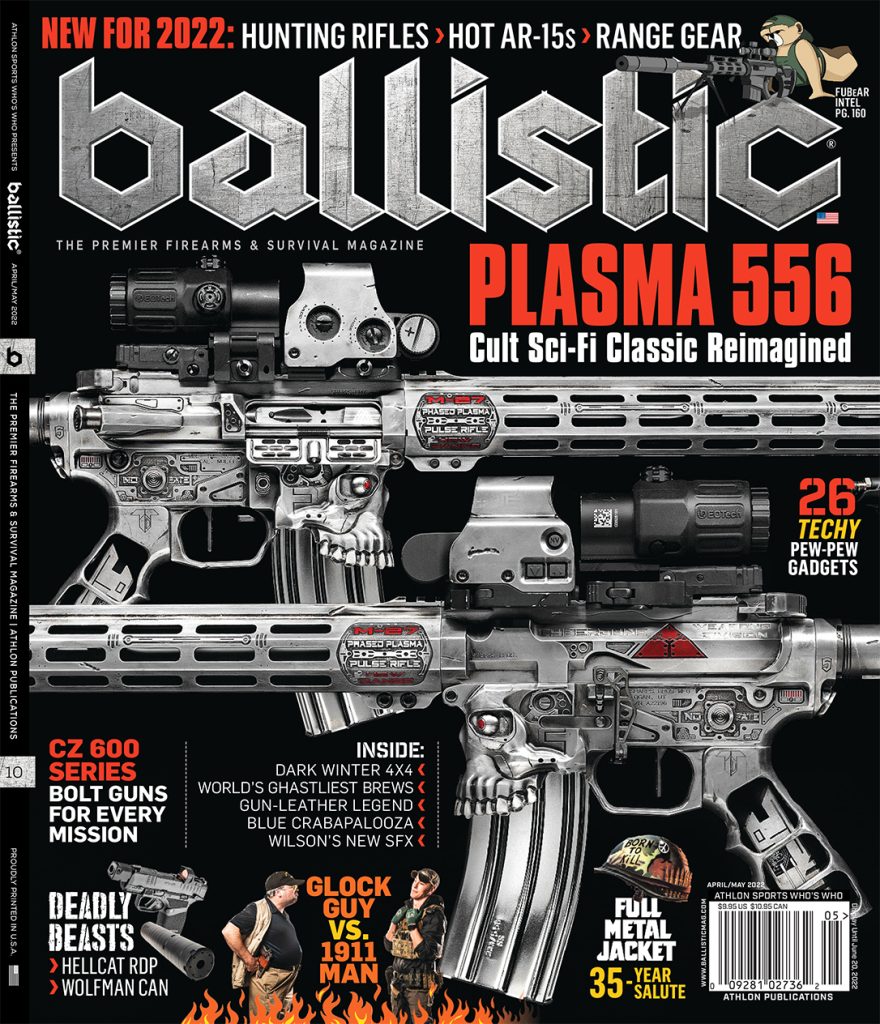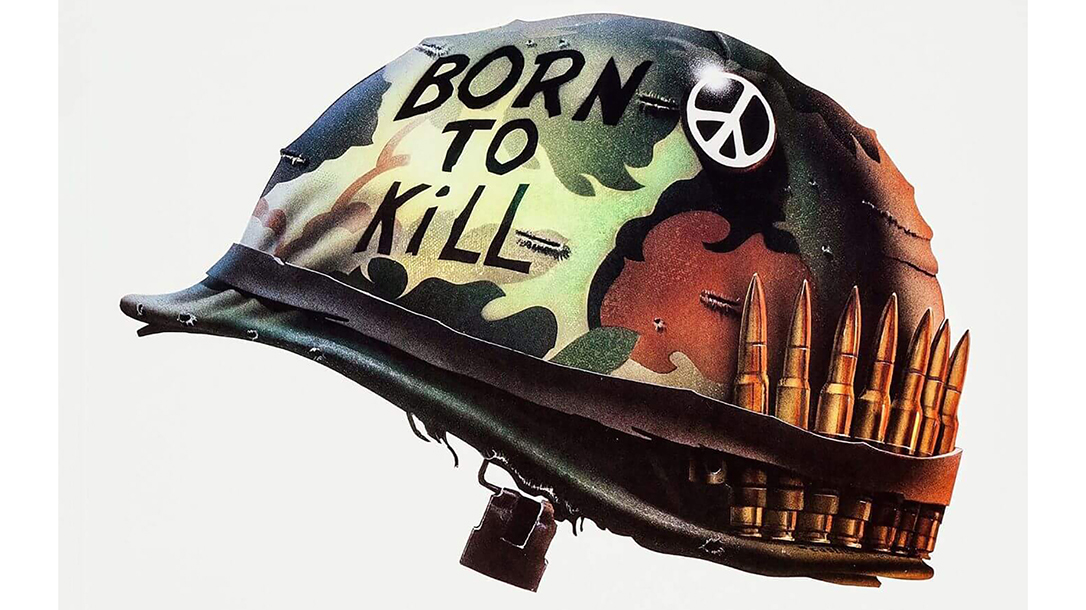Released 35 years ago during the wave of Vietnam War films in the 1980s, Stanley Kubrick’s Full Metal Jacket was unique in that it showed two very different sides of the war. Based on the 1979 novel The Short-Timers by Gustav Hasford, who co-authored the screenplay with Kubrick, the movie included an extended boot camp training sequence at the Marine Corps Recruit Depot Parris Island, South Carolina, before turning its focus on a Marine Rifle Platoon during the Tet Offensive. Moreover, unlike most films that were centered on the war in Southeast Asia in the jungles and highlands of South Vietnam, Kubrick opted to set his film in the cities of Da Nang and Huế.
Full Metal Jacket Trivia
The film’s title refers to the “full metal jacket” (FMJ) bullet that was carried by U.S. servicemen during the war. It was a hard-hitting film that arrived in theaters in the summer of 1987. It quickly received critical acclaim and was even nominated for an Academy Award for Best Adapted Screenplay. However, there are many facets of the film that might have been missed.
On Location
Due to the fact the United States and Socialist Republic of Vietnam weren’t exactly on good relations following the war and into the late 1990s, it was impossible for any of the films about the conflict to actually be filmed in Vietnam.
Advertisement — Continue Reading Below
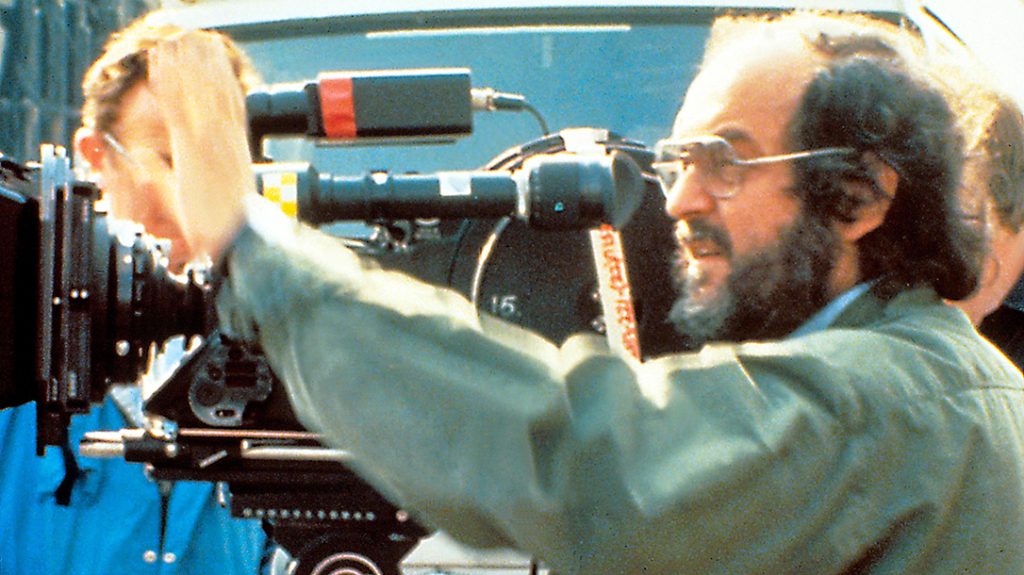
Other films were quite creative, beginning with The Green Berets, the only film to have U.S. Department of Defense cooperation. Filmed in the summer of 1967 at Fort Benning, Georgia, many sets later saw use to train soldiers awaiting deployment to Southeast Asia. After the war, filmmakers had to get even more creative, and that included virtually no cooperation from the U.S. military. As a result, The Deer Hunter (1978) filmed in Thailand, while Apocalypse Now (1979) recreated the war in Southeast Asia in the Philippines. The Filipino military was still using U.S. military equipment not all that different from what had been in use during the actual conflict and provided assistance on the film.
Kubrick went in a completely direction with Full Metal Jacket. All principal photography took place in England in 1985 and 1986. Bassingbourn Barracks, a former Royal Air Force Station and later a British Army base, stood in for Parris Island.
Advertisement — Continue Reading Below
London Calling
Even the sequences in Vietnam completely took place and filmed in the UK; much actually occurred in London’s East End. The production successfully transformed the abandoned Millennium Mills and Beckton Gas Works, built in the late 19th century, along with the docklands section of the Isle of Dogs, into the Vietnamese cities. Kubrick, who rarely traveled out of the UK, had been scouting locations and found that the Gas Works closely resembled some sections of Huế. Because demolition was already underway, Kubrick was able to have buildings demolished as part of the action, and for some two months the film’s art director carefully staged the area to make it further resemble the ancient Southeast Asian city. The Thames marshlands of Cliffe-At-Hoo in Kent, England, provided backdrop for a few of the film’s open country scenes.
Some 200 imported Spanish palm trees, along with more than 100,000 plastic tropical plants, helped turn England into Vietnam.
For the actors, it meant having to deal with asbestos and other chemicals in the former factories, but also the English weather that was far chillier than that of Southeast Asia, which could help explain why no one seems to be suffering in the tropical heat.
Advertisement — Continue Reading Below
In terms of equipment, Kubrick borrowed four M41 tanks from a Belgian army colonel who privately owned them while Westland Wessex helicopters had to stand in for the Marine Corps’ actual Sikorsky H-34 Choctaw helicopters.
Eyes Off The Enemy
Full Metal Jacket was not Kubrick’s first war film. While the reclusive director only made 13 feature-length movies during his career; two remain considered true war films (Paths of Glory and Full Metal Jacket) while three more (Spartacus, Dr. Strangelove and Barry Lyndon) also explored the themes of the military and war.
What is unique in his take on war is that Kubrick rarely showed the enemy. 1957’s Paths of Glory, arguably one of the era’s most notable “anti-war” films, takes place during the First World War. It focuses on the French Army’s suicidal attack on a formidable German position and the aftermath where some of the French soldiers who retreated suffer execution for cowardice. Unlike other films that would show the enemy’s perspective at least in a few establishing shots, Paths of Glory features not a single German soldier on screen, and that begs the question at the end, “who is the enemy?”
Advertisement — Continue Reading Below
Full Metal Jacket offers an equally somber view on war. In his take on the Vietnam War, Kubrick again keeps the enemy largely unseen. Much like how Steven Spielberg found that “less” was more with Jaws, the result is impressive. Instead of masses of People’s Army of Vietnam (PAVN) soldiers or VietCong, the American Marines in Full Metal Jacket face a largely unseen enemy, hidden and in unknown numbers. Despite no waves of enemy attacks, the combat sequences are no less intense. In fact, only a handful of VietCong ever see time on screen, including a single female sniper.
FMJ Firepower
During the first half of Full Metal Jacket, focusing on the boot camp sequence at Parris Island, the movie focuses much attention on the M14 during the U.S. Marine boot camp scenes. Period accurate–Marines drilled with the M14 during basic training. The Corps then issued them the M16 when they arrived in Vietnam.
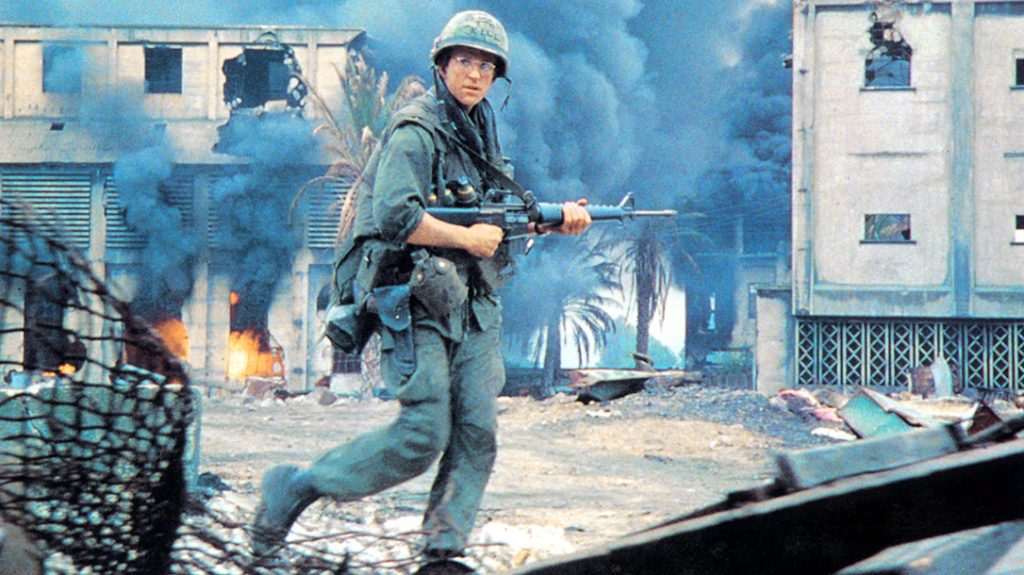
Advertisement — Continue Reading Below
But what the film gets wrong is showing Marines using the Colt Model 604, a version of the M16, adopted by the United States Air Force. it lacked the forward assist and had the partial magazine fence of the XM16E1. Actual Marines could have carried the M16A1 at the time of the Tet Offensive. The movie shows Marines carrying the MGC M16 Replica rifles in some sequences as well.
While not really explained in the film, one character, Crazy Earl, carries a lever-action Daisy Red Ryder BB Gun. The same character carries this “weapon” in the book the movie derives from, The Short Timers.
No Love for the AK
The Red Ryder likely pops up unexpected to the viewer. But another surprise comes in the lack of even a single AK-47 actually seen on screen. Several Viet Cong characters appear in the distance. Many believe they carry the Czech-made SA Vz.58, a close resemblance of the AK-47, but featuring a completely different operation. This may have been due to the fact that during the Cold War, it was nearly impossible for western armorers to have access to the AK-47. Many films of the era relied on the Chinese Norinco Type 56, but even those would have been difficult to import into the UK. It is likely that the film’s armorers had access to the SA Vz.58, which wasn’t really inaccurate for the era.
Advertisement — Continue Reading Below
The People’s Army of Vietnam did, in fact, field the SA VZ.58, alongside the predominant Soviet AK-47 and Chinese Type 56 rifles. Each weapon used the Soviet 7.62x39m caliber round. But it remains unlikely that a Viet Cong sniper used one. A “VC sniper”, played by Ngoc Le, also carried one, an odd choice for a marksmen.
An SKS would have proved the more appropriate choice of weapon. Even a captured M1 Carbine, perhaps captured during the First Indo-China War against the French, arguably makes a better choice. But it is another aspect that sets Full Metal Jacket apart form other Vietnam War movies.
The Late Great Gunny
The late R. Lee Ermey, a former Marine Corps drill instructor, originally singed on as the film’s technical advisor. He had previously provided his experience to Francis Ford Coppola during the making of Apocalypse Now. Ermey, attending the University of Manila using his G.I. benefits when cast in that film, impressed Coppola, who hired him as an advisor.
Advertisement — Continue Reading Below
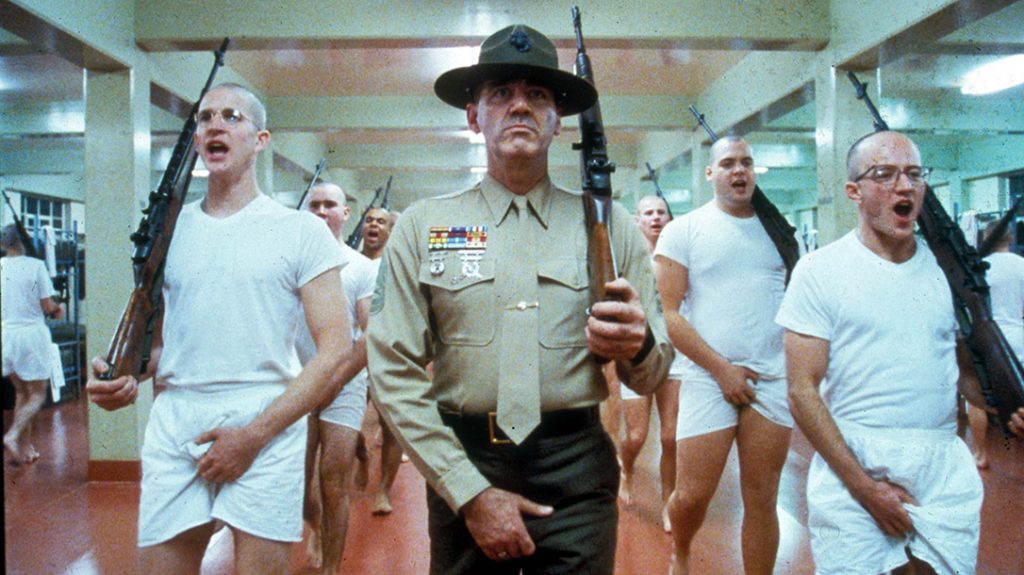
Hired again as a technical advisor for Full Metal Jacket, Ermey requested an audition for the role of Gunnery Sergeant Hartman. Initially Kubrick declined—as he had seen Ermey’s portrayal of drill instructor Staff Sergeant Loyce in The Boys in Company C made nearly a decade earlier and felt he wasn’t mean enough.
However, Ermey improvised some insulting, and notably colorful, dialog and successfully demonstrated his ability to show how a good drill instructor would successfully break down new recruits (see sidebar for more). That impressed Kubrick, who felt he was not only perfect for the role but ended up providing about half of the character’s dialog. And to further help ensure that the dialog felt authentic, Ermey actually did little rehearsing with the rest of the cast. Kubrick maintained a reputation as a perfectionist, often shooting endless takes. But most of Ermey’s scenes completed shooting after just two or three takes.
Advertisement — Continue Reading Below
As an aside, while driving back from the set, Ermey’s car skidded off the road, and he broke all his ribs on his side. Unable to get out of the wreck, he kept flashing his lights until a motorist stopped to help him.
Actor Tim Colceri, originally promised the role of Gunnery Sergeant Hartman, still appeared in the film as a helicopter door gunner, uttering the much-quoted lines, “Get Some!” and “Ain’g War Hell?”
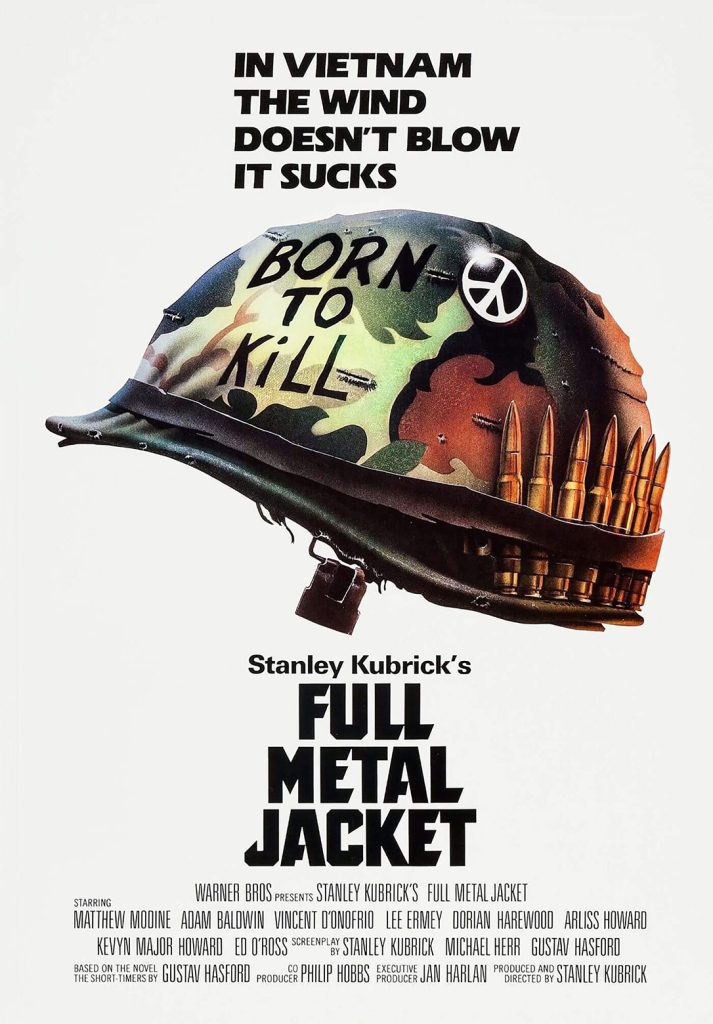
Soundtrack
Full Metal Jacket wasn’t the first Vietnam War film to feature period music. Apocalypse Now has used The Doors’ “The End” as the opening theme, and also included music by The Rolling Stones and The Beach Boys. Yet, the selection of songs chosen by Kubrick for Full Metal Jacket is also unique from other war films about the conflict.
Instead of the normal rock repertoire, Kubrick included “Chapel Of Love” by the Dixie Cups, “Wooly Bully” by Sam the Sham & the Pharaohs, Chris Kenner’s “I Like It Like That” and “Surfin’ Bird” by The Trashmen. The selection of songs was chosen to emphasize the absurdity of the situation the soldiers were facing.
In addition, Full Metal Jacket had the distinction of being sampled—where dialog was used by musical artists of the late 1980s. The industrial metal band Ministry’s “Thieves,” from its fourth studio album The Mind Is a Terrible Thing to Taste, used dialog samples from R. Lee Ermey’s drill instructor character.
However, one of the more “infamous” of samples to come out of the film was the dialog uttered by actress Papillon Soo Soo, who played the Da Nang prostitute: “Me so horny. Me love you long time. Me sucky sucky.” Titled simply, “Me So Horney,” from rap group 2 Live Crew’s album As Nasty As They Wanna Be, achieved more notoriety than the film as the explicit nature of the lyrics led to the group facing obscenity charges while the album was even banned for sale in Florida. That line “me so horny” was also sampled again for 1992’s “Baby Got Back” by rapper Sir Mix-a-Lot.
This article appeared in the April-May 2022 issue of Ballistic Magazine. Get your copy now at OutdoorGroupStore.com.
